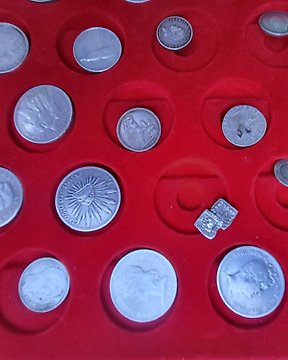
Świat. Collection of coins
Nr 83246383

Nr 83246383

Must be seen. No reserve price ! Please have a look at the pictures.
Large, attractive and varied collection coins from the Dutch Colonial & Overseas Territories. unsorted and starting from 1737 up to 2010. More than 235 pieces (!) with many interesting coins and more than 35 (!) SILVER pieces. (approx. 15% of the the whole lot are silver coins).
Amongst others:
* Colonial Dutch East Indies with 1/2 (scarce) , one and double VOC- Doits from various provinces
* Colonial Netherlands East Indies silver 1/10 and 1/4 silver coins including high quality and war time minted in the USA.
* Coins from Batavia and the Island of Sumatra
* Old coins Willem I (1815-1840) and Willem III (1849-1890 including silver)
* Several 18 and early 19th Century coins from the Sultanate Palembang, Sumatra,
* Curacao including Colonial silver and several exceptional high quality copper coins,
* Aruba, Dutch Antilles with many silver 1/10, 1/4 , 1 and 10 Guilder coins and many in exceptional high quality. * Suriname including many high quality,
******** better grades, better dates....... and many many more....***********
Please have a look at our other Catawiki auction lots for more coin collections. and/or add us to your favourites to find our future auction lots easily.
Bid with confidence. AG-Worldcoins, over 3000 lots sold on Catawiki. High feedback score.
Please evaluate this lot with reference to the images provided.
Will be sent via registered mail.
I charge only 1x shipping costs when you buy multiple lots in the same auction.
You are welcome to bid on my other items:
https://veiling.catawiki.nl/aanbod/hamaca
extra info:
The Dutch colonial empire (Dutch: Nederlandse koloniale rijk) comprised the overseas territories and trading posts controlled and administered by Dutch chartered companies—mainly the Dutch East India Company and the Dutch West India Company—and subsequently by the Dutch Republic (1581–1795), and by the modern Kingdom of the Netherlands after 1815.[1] It was initially a trade-based system which derived most of its influence from merchant enterprise and from Dutch control of international maritime shipping routes through strategically placed outposts, rather than from expansive territorial ventures.[2][1] The Dutch were among the earliest empire-builders of Europe, following Spain and Portugal and one of the wealthiest nations of that time.[citation needed]
With a few notable exceptions, the majority of the Dutch colonial empire's overseas holdings consisted of coastal forts, factories, and port settlements with varying degrees of incorporation of their hinterlands and surrounding regions.[2] Dutch chartered companies often dictated that their possessions be kept as confined as possible in order to avoid unnecessary expense,[3] and while some such as the Dutch Cape Colony and Dutch East Indies expanded anyway (due to the pressure of independent-minded Dutch colonists), others remained undeveloped, isolated trading centres dependent on an indigenous host-nation.[2] This reflected the primary purpose of the Dutch colonial empire: commercial exchange as opposed to sovereignty over homogeneous landmasses.[2]
The imperial ambitions of the Dutch were bolstered by the strength of their existing shipping industry, as well as the key role they played in the expansion of maritime trade between Europe and the Orient.[4] Because small European trading-companies often lacked the capital or the manpower for large-scale operations, the States General chartered larger organisations—the Dutch West India Company and the Dutch East India Company—in the early seventeenth century.[4] These were considered the largest and most extensive maritime trading companies at the time, and once held a virtual monopoly on strategic European shipping-routes westward through the Southern Hemisphere around South America through the Strait of Magellan, and eastward around Africa, past the Cape of Good Hope.[4] The companies' domination of global commerce contributed greatly to a commercial revolution and a cultural flowering in the Netherlands of the 17th century, known as the Dutch Golden Age.[5] In their search for new trade passages between Asia and Europe, Dutch navigators explored and charted distant regions such as Australia, New Zealand, Tasmania, and parts of the eastern coast of North America.[6] During the period of proto-industrialization, the empire received 50% of textiles and 80% of silks import from the India's Mughal Empire, chiefly from its most developed region known as Bengal Subah.[7][8][9][10]
In the 18th century, the Dutch colonial empire began to decline as a result of being overwhelmed from the Fourth Anglo-Dutch War of 1780–1784, in which the Dutch Republic lost a number of its colonial possessions and trade monopolies to the British Empire and French colonial empire, along with the conquest of the Mughal Bengal at the Battle of Plassey by the British East India Company.[11][12][13] Nevertheless, major portions of the empire surv≈ived until the advent of global decolonisation following World War II, namely the East Indies and Dutch Guiana.[14] Three former colonial territories in the West Indies islands around the Caribbean Sea—Aruba, Curaçao, and Sint Maarten—remain as constituent countries represented within the Kingdom of the Netherlands.[14]
Wikipedia
Jak kupować w serwisie Catawiki
1. Odkryj coś wyjątkowego
2. Złóż najwyższą ofertę
3. Dokonaj bezpiecznej płatności